Formulating and Fortifying with Proteins
Presenters at Prepared Foods' R&D Seminars discussed the various ways foods and beverages can be fortified with ingredients that improve their functional characteristics and meet consumers' ever-growing protein needs.
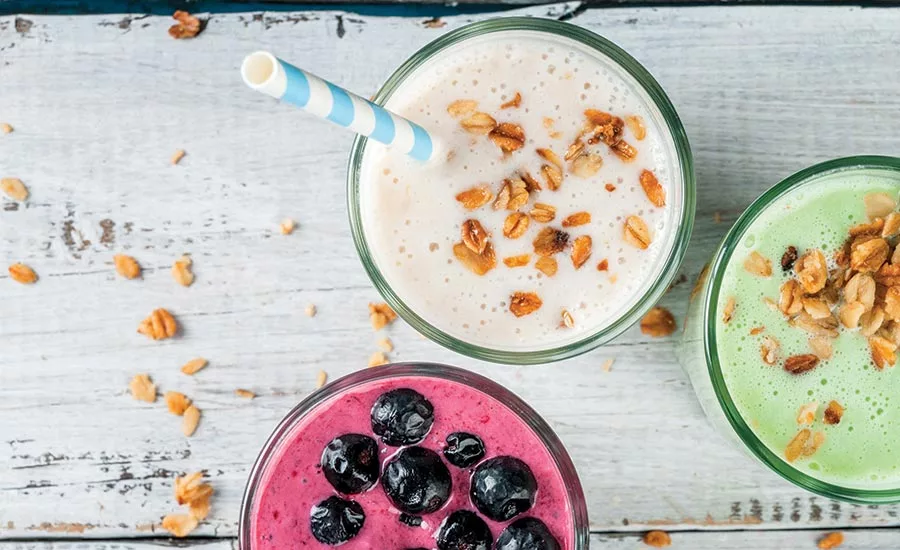
SOURCE: ©iStockphoto / Rimma Bondarenko
Collagen Protein College
Collagen is a family of pure proteins with functional benefits in food and beverages. Collagen, gelatin and collagen peptides have specific functions and benefits, including bloom, viscosity, particle size, isoelectric point, melting properties, heat stability and dissolution. Particle sizes range from eight mesh (like sea salt) for high concentrations; to 30 mesh (like sand) for low concentrations; to 40 mesh (fine powder), also for low concentrations.
Native collagen is sourced mainly from bovine and porcine hide and bone, and some from poultry. Suppliers are carefully audited, and raw materials are subject to stringent quality control. Their amino acid composition and molecular structure contribute to their unique properties.
“Melting point depends on gelatin concentration, physical properties (bloom and viscosity), temperature and presence of other ingredients,” explained Ginger Waller, supervisor, Edible Technical Services, at Gelita. “Gelatin’s heat stability affects bloom; gel strength is decreased with extended heat, and viscosity is also decreased at high temperatures,” she added. Gelatin dissolution is influenced by particle size, concentration, time and equipment constraints.
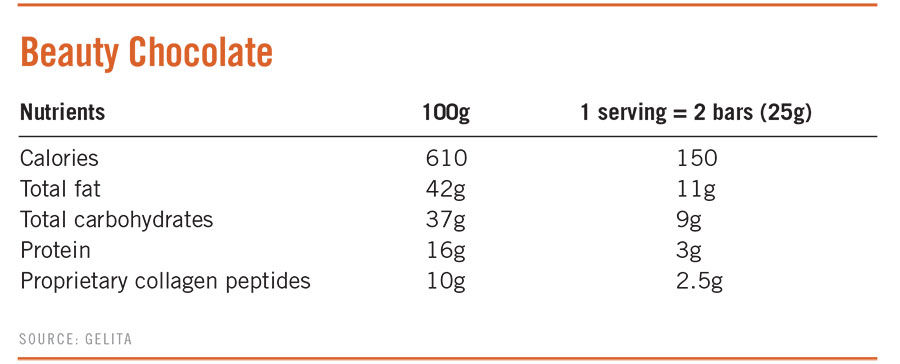
Nutrition information for a dark chocolate with a high cocoa content of 68%, creamy with excellent melting properties and a 12-month shelflife, providing protein enrichment, mobility and beauty benefits. One serving of two bars, at 12.5g each, contains 2.5g proprietary collagen peptides.
Collagen proteins are often utilized, because they are fat-, cholesterol- and carbohydrate-free pure proteins. They are also a natural, highly digestible, non-allergenic food with a clean label. Their functional properties include gelling, aerating, emulsifying, stabilizing, protecting, binding water and adhesion.
“In foods,” Waller stated, “collagen proteins provide a one-of-a-kind mouthfeel, improved texture, thermo- reversible gels, clarity and flavor release in confectionery, desserts and other culinary creations.”
For example, protein-enriched gummy candies with collagen proteins have a familiar texture and mouthfeel, with increased protein, reduced calories and carbohydrates. In marshmallows and mousses, collagen proteins function to aerate, thus providing superior whipping, elastic texture and foam stability. Gelatin is used in whipped cream cheese, increasing volume with air and water, for significant calorie and fat reduction, plus a creamy texture.
Looking for quick answers on food safety topics?
Try Ask FSM, our new smart AI search tool.
Ask FSM →
As emulsifiers, water-and-oil systems like dairy spreads, cheeses and creams can benefit from gelatin. Reduced-fat margarines and spreads using collagen proteins can replace fat and calories with air and water, resulting in fewer calories, less fat and a creamy-smooth texture.
Waller also suggested that collagen proteins as stabilizers promote no water separation; have smooth textures; and are compatible with other hydrocolloids, mimicking fat in yogurt, sour cream and salad dressings. They are a protective colloid—controlling crystallization; providing heat-shock resistance; and maintaining texture in ice creams and frozen products. Collagens are also beneficial in bars, desserts, crunchy snacks and meats, as both binders and adhesive agents.
Instant gelatin is recommended in savory or sweet applications, and aerated products, to eliminate a heat step for dissolution. They improve aeration with cold dispersion; replace egg and fat; and provide freeze-thaw stability.
Collagen peptides are known for their positive impact on joint health, mobility, and on skin, hair and nails. Collagen is the most abundant protein in the body, accounting for greater than 30% of the whole body’s protein. It is a major component of connective tissue (skin, bones, tendons, ligaments, spinal discs); 70% of cartilage dry mass; and 70-80% of skin’s dry mass-responsible for mechanical strength. Abundant clinical evidence shows improved mobility and joint cartilage after three months of collagen ingestion.
Waller added that “topical applications provide temporary improvement of skin conditions, short-term masking of skin problems, strictly limited to epidermal structures. Beauty-from-within products can promote significant and enduring improvement of skin conditions; casual treatment of skin aging; and have a direct effect on dermis and [the] skin’s extracellular matrix.”
“Collagen Protein College,” Ginger Waller, supervisor, Edible Technical Services, 712-943-0382, ginger.waller@gelita.com
—Summary by Elizabeth Pelofske, Contributing Editor
Formulating with Gelatin and Collagen Peptides
Gelatin and collagen peptides are used in the food, pharmaceutical and photographic industries. Gelatin is warm- or cold-water soluble and contributes gelling, water-binding, foaming, elasticity, emulsification, film-formation and viscosity functions. When gelatin is further processed into lower molecular weight collagen peptides, properties are changed. Collagen peptides are cold-water soluble with no gelling properties and have application uses in beauty-from-within, bone-and-joint-health and protein-supplement products. Production process of gelatin and collagen peptides affects their bloom, viscosity, isoelectric point, color, odor and mesh profile characteristics.
As explained by Kevin Paulsen, specialty protein product manager for PB Leiner USA, “Gelatin melts at body temperature, resulting in excellent flavor release and mouthfeel and does not adhere to the teeth. It forms unique thermo-reversible gels, contributing to flavor release, texture and exceptional clarity, for a truly irreplaceable ingredient.”
Gelatin also possesses superior aeration and whipping properties. More elastic than other whipping agents, gelatin increases viscosity around air bubbles formed during whipping—creating a stable structure.
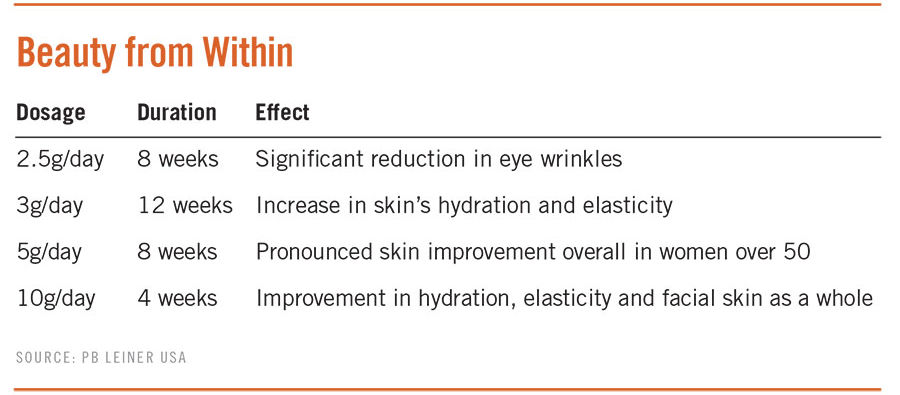
Collagen peptides increase skin’s elasticity, hydration and smoothness; decrease wrinkles and fine lines; and are ideal for multiple delivery systems. Findings for dosage and durations are listed above.
Gelatin is widely used to stabilize emulsions in dairy products and salad dressings, because it inhibits breakdown of emulsions during storage and spreading. And use of gelatin can help reduce fat, while maintaining desired texture.
Collagen peptides are derived by enzymatic hydrolysis of collagen. They are cold-soluble, fine-powdered ingredients that are ideal for instant drink preparations. Gelatin and collagen peptides contain many essential amino acids and high amounts of glycine, proline and hydroxyproline. When blended with other common proteins, a PDCAAS 1 can be achieved.
Promoting health and beauty, a positive impact on joint function has been demonstrated by several clinical studies. Many diets are lacking in glycine and proline, which are considered elementary building blocks for connective tissue. Collagen peptides also can help increase bone size and density; help heal wounds; and maintain healthy skin, hair and nails.
Collagen peptides also have a positive impact on energy metabolism of muscle cells. “Collagen peptides are the unsung heroes of protein,” offered Paulsen.
Standard gelatin is a high-molecular-weight protein derived from collagen requiring hot water for dissolution and gelling power. This is limiting for some applications, but a solution to this issue is opening new and exciting applications. Cold-soluble gelatin does not require thermal processing; is soluble in cold water or milk; is easy and fast to use; and is fast-setting. It has the same functions as standard gelatin, and it is ideal for instant dessert mixes, DIY kits, frozen entrees, beverages and applications where cold processing is an advantage.
Gelatin and collagen peptides are natural, pure proteins; they are free from fat, carbohydrates, cholesterol, additives and are non-allergenic. In most countries, they are considered a food ingredient (no E number in Europe). Growth is expected to continue globally, in confectionery capsules, microencapsulation, beauty, dairy, desserts and many other areas.
“Formulating with Gelatin and Collagen Peptides,” Kevin Paulsen, specialty protein product manager, PB Leiner USA, 563-940-7490, Kevin.paulsen@pbleiner.com
—Summary by Elizabeth Pelofske, Contributing Editor
Stabilization of RTD Protein Beverages
Heightened awareness of protein benefits has led to wider availability of beverages containing milk and plant proteins. Proteins now are consumed as an energy source, for weight management, and to gain muscle mass and strength. In development of protein beverages, hydrocolloids help prevent protein aggregation, add texture and promote particle suspension.
Acidified and fermented milk drinks, typically pH 3.8-4.5, often contain proteins from whole milk, skim milk, whey or soy. Acidification occurs through use of live bacteria (lactic acid fermentation), by adding fruit juice or a food-derived acid. Beverages fermented with live bacteria have typical shelflives of approximately four weeks; with direct acidification, the shelflife can be from six-12 months.
As explained by Julie Masker, scientist, Applications, R&D and Technical Service, at Ashland Specialty Ingredients, “Acidified or fermented milk drinks contain surface reactive casein micelles which tend to aggregate, precipitate and settle. This aggregation or coagulation can be induced by acid, heat and time,” she noted.
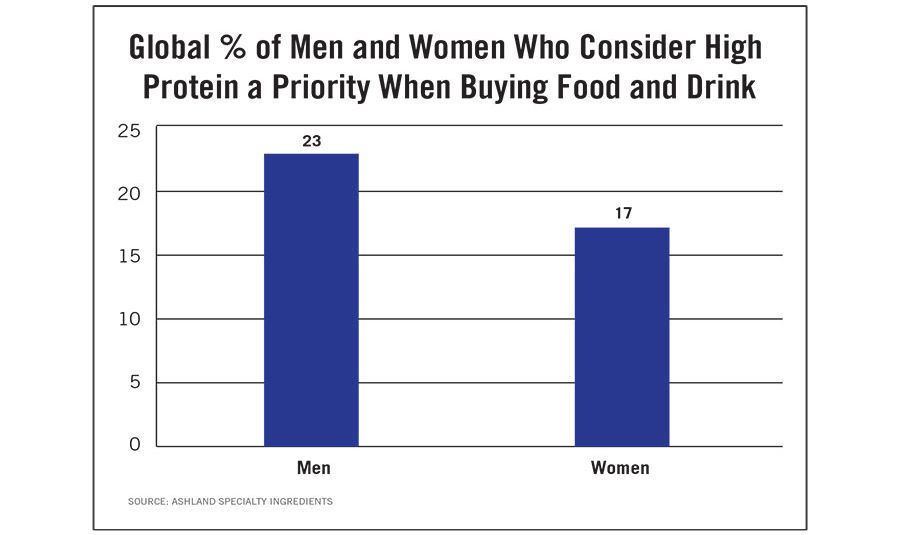
According to a Canadian Consumer’s Global Survey in 2013, 23% of men and 17% of women consider high protein a priority when purchasing food and beverages. Also found was that 34% of consumers aged 18 to 24 try to eat as much protein as possible. The National Marketing Institute, Protein Trends & Technology Seminar in 2015 stated that 21% of the general population consider themselves to be protein deficient.
Cellulose gum added to milk beverages can prevent aggregation of casein micelles. Soluble in cold or hot water, acid-tolerant grades are available. While cost-effective, cellulose gum promotes a clear solution, increases viscosity, imparts a clean mouthfeel and has a smooth flow when pouring. Typical use levels are 0.2-0.8% depending on product.
High methoxyl pectin requires heat to dissolve and is used most commonly in low pH (below 4.5-5) applications. Most commercial pectin is standardized with sucrose and has a higher relative cost. Typical use rate is 0.2-0.5%. Cellulose gum and pectin both stabilize the proteins by preventing protein-protein interactions.
Neutral pH dairy beverages at pH 4.6-7.5 also often contain non-fat milk solids, skim or whole milk, and/or whey or soy proteins. Shelflives of six-12 months can be expected, if aseptically processed. Pasteurized, refrigerated beverages can have just six-12 weeks shelflife.
“Density differences between particles can result in sedimentation, and particles aggregate and form a separate layer. Gelation also can occur as the product ages, when beta-lactoglobulin molecules from whey interact with kappa-casein on the outer part of the casein micelle. To enhance stability and minimize density difference, viscosity can be increased, and particle size decreased,” noted Masker.
Carrageenan (most often kappa), sourced from red seaweed, is commonly used to create a gel network, surrounding aggregates of protein and fat droplets, stabilizing the suspension. Usage rate is typically 0.02%. Neutral-pH dairy beverages also benefit from gellan gum, produced by bio-fermentation. Gelation is created through a network of small, invisible gel particles. Gellan gum requires heat to hydrate, and it requires cooling with shear. Typical use level is about 0.12%.
Plant-based protein beverages with soy, pea, rice, flax, chia, hemp or quinoa have similar issues, shelflives and solutions as neutral dairy beverages, Masker said.
Masker suggested that gellan gum and carrageenan work well in plant-based protein beverages, but blends of guar and xanthan gum also can work synergistically. Xanthan gum is pseudoplastic or shear-thinning, but guar can leave a beany flavor. Xanthan gum can impart an undesirable texture but is cost-effective at typical use rates of 0.01-0.1%.
Juice beverages, typically pH 2.4-4.0, may contain juice or no juice. Acidified whey protein isolates are the typical protein source, possibly shelf-stable for six-12 months, depending on product. Cellulose gum and xanthan gum can be used for stabilization.
Product developers should be aware of protein instability and hydrocolloids as useful tools for stabilization. Choosing the correct hydrocolloid depends on the system requirements. Reaching out to hydrocolloid companies can help achieve maximum hydrocolloid functionality.
“Stabilization of Ready-to-drink Protein Beverages,” Julie Masker, scientist, Applications, R&D and Technical Service at Ashland Specialty Ingredients, 302-995-3298, JKMasker@ashland.com
—Summary by Elizabeth Pelofske, Contributing Editor
A Novel Protein Ingredient for Your Next Innovation
What are water lentils? Are there any unique attributes of water lentils for nutritional advantage? Is it possible to be successful in applications of water lentil powder in food products? These are the pertinent questions in “A Novel Protein Ingredient for Your Next Innovation,” a presentation given by Supaporn Naknukool, Ph.D., Parabel USA Inc., at a 2017 Prepared Foods R&D Seminars.
Naknukool began by explaining what water lentils are, and that they are known by other names (lenteja de agua, lentilles d’eau, khai nam [water eggs] and shobuj shona [green gold]). Free-floating aquatic plants from the Lemnaceae family, these rapidly growing plants have found use as a model system for studies in community ecology, basic plant biology, ecotoxicology and in the production of biopharmaceuticals, she averred. They are also a source of animal feed for agriculture and aquaculture.
In fact, a 1989 FAO report called these versatile plants “…a tiny aquatic plant which has enormous potential for agriculture and the environment.” In Southeast Asia, Naknukool pointed out, water lentils are already a human food resource in traditional/small farmer systems. They have been consumed as a food source by Burmese, Laotians and Northern Thailand people for many generations. Thais refer to water lentils as khai nam or “eggs of the water,” and regard them as a highly nutritious food. Delicious foods prepared with water lentils as an ingredient in Southeast Asia include: water lentil chiffon cake, water lentil curry and water lentil omelets. They also go well as an ingredient in western dishes, such as salads and veggie burgers.
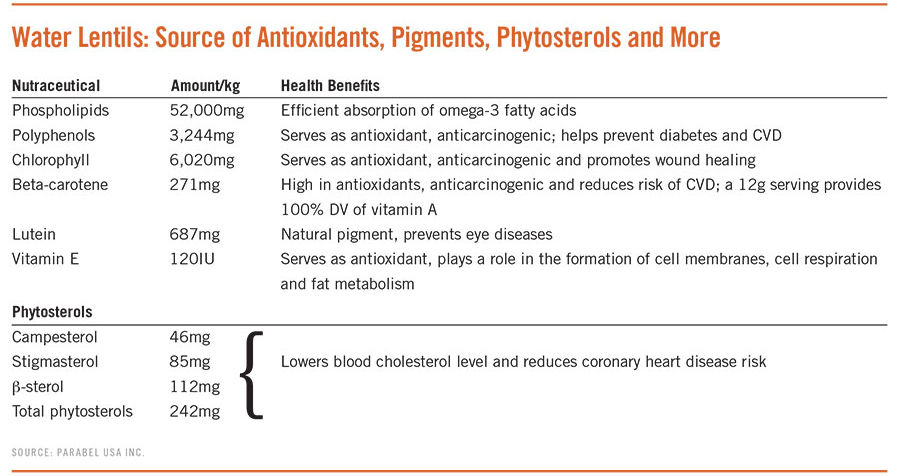
Water lentils are found worldwide, yet grow best at temperatures 18-30ᵒ C. Optimized growth systems allow for very high growth rates and year-round harvest. Grown under the optimized nutrients, water lentils have an average of 40-45% crude protein on a dry matter basis (DMB). Growth media, water and fertilizer need to be regularly monitored for crop quality and composition, as well as potential contamination from heavy metals, pathogens and other undesirables, Naknukool said.
Water lentils’ actual water footprint is five times lower than for other vegetable proteins and 10-40 times lower than for animal proteins. Cultivation of water lentils emits CO2 that is 27 times less than cattle farming to generate 1kg of fresh product. Water lentil yields 20 tons dry matter per hectare a year (dm/ha/year) and provide almost 10 times as much protein/ha/year as soy beans. They require only two to three weeks from inoculation to reach production.No other crop has this potential.
Water lentils have been recommended as a nutritious food; they are considered a great source of all essential amino acids. Their essential amino acid content is higher than soy, pea, algal and hemp. Water lentils’ branched-chain amino acid (BCAA) content is also higher than soy, pea, algae (chlorella) and hemp, while they have a comparable amino acid profile to whey protein.
Naknukool stated that water lentils also are one of the most complete plant-based protein sources, citing their PDCAAS measurements (a measure of amino acid content and protein digestibility) as value of 0.93-089. They are considered a complete protein, meaning it provides required amounts of nine essential amino acids. Water lentils are also rich in plant-based omega-3 fatty acids (α-linolenic acid, ALA), which are essential for optimal cardiovascular, brain and eye function. Naknukool noted that one serving of water lentils provide 38% of male RDA and 55% of female RDA of omega-3 fatty acids.
This incredibly versatile plant also contains minerals that are essential for proper health, growth and development—including calcium, iron, magnesium, manganese, phosphorous, sodium, zinc, molybdenum and boron.
And, to add to their nutrition powerhouse status, they also contain soluble/insoluble dietary fiber at perfect ratio (2:8). Insoluble fiber aides in weight loss (provides satiety); promotes regular bowel movements; and prevents constipation. Soluble fiber promotes gut health; can contribute to diabetes protection; and can contribute to a reduction of blood cholesterol levels (heart health benefit). Another strong point in water lentils’ favor is that they’re a good source of natural antioxidants, pigments, polyphenols, phytosterols and flavonoids (see chart, “Water Lentils: Source of Antioxidants, Pigments, Phytosterols and More”).
Lastly, Naknukool discussed how to have successful applications of water lentil powder in food products. Dispersibility of Lentein Powder, made from water lentils, is excellent and close to whey protein concentrate. Lentein Powder has an outstanding water- and oil-absorption capacity. It is well-dispersed and provides smooth texture in beverage or soup applications. It is an excellent ingredient for label claims, including “good source of protein” and “good source of fiber.”
Together with protein from other sources, Lentein Powder is a suitable protein source in meal replacement drinks or soups. Lentein Powder can be used in both savory and sweet dishes. Naknukool took the audience through various applications for Lentein Powder, including those for bakery, pasta and sausage.
In bakery, reformulation with Lentein Powder into gluten-free bakery products can boost fiber content; improve protein quality; provide a higher protein content; and improve essential amino acid content. Recommended usage level is up to 10% and it has a minor impact on water absorption and rheological characteristics. Inclusion levels of >10% would interfere the softness and density of the cake, she warned. In the finished product, Lentein Powder in bakery products provides green color and mild matcha-like flavor. Its flavor easily goes complements flavors such as chocolate, almond and coconut.
When used in pasta, Lentein Powder can be claimed as a good source of fiber; improves the pasta’s protein quality; and has an improved essential amino acid content. The addition of this powder does not modify cooking loss and cooking weight of the pasta at recommended usage levels of 10%.
In sausage, Lentein Powder can be incorporated into meat products to reduce cost in formulation; reduce cooking loss; and it retains the product’s size and form. Substitution level of < 5% is recommended for sausage applications. Flavoring agents, such as garlic, black pepper and caraway, is recommended.
The superior dispersibility of Lentein Powder allows it for use in many different applications, such as protein shakes, smoothies, soups and more.
“A Novel Protein Ingredient for Your Next Innovation,” Supaporn Naknukool, Ph.D., Parabel USA Inc., snaknukool@parabel.com; Alternate contact: Cecelia Wittbjer, 321-405-9250 / cwittbjer@parabel.com
—Summary by Barbara T. Nessinger, Contributing Editor
This article was originally posted on www.preparedfoods.com.







